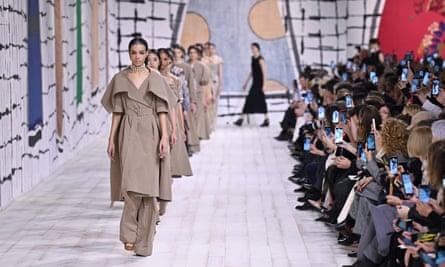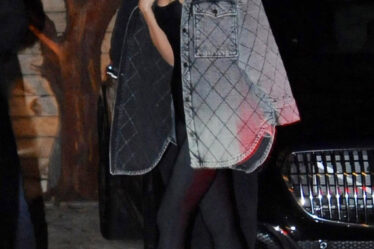
Outside, Rihanna’s surprise arrival at the Dior haute couture catwalk show was grinding several blocks of central Paris to gridlock. Inside, Maria Grazia Chiuri, the creative director, was discussing the gender politics of fabric as a raw material in art and how Walter Benjamin’s seminal essay The Work of Art in the Age of Mechanical Reproduction relates to the modern luxury industry.
Dior under Chiuri has become bigger, more profitable, and more high profile than ever before, at the same time as becoming more radical and values-driven. The Lady Dior and Book Tote “It” bags fly out of glitzy airport boutiques; meanwhile, the feminist artist Judy Chicago stars in advertising campaigns.
Actors Natalie Portman and Jennifer Lawrence wear fairytale Dior gowns on the red carpet, while catwalk collections are constructed around deep-dive narratives of the ways women of colour have been overlooked in fashion history. It feels contradictory – and yet it seems to be working. Fashion reflects the world we live in, after all, and the 21st century is nothing if not confusing.
Dior works because it makes the paradox of blockbuster entertainment and intellectual soul-searching feel fun. Take Rihanna, whose puffer jacket had been reimagined in the silhouette of Dior’s classic bar jacket, with a cinched waist flaring to a peplum over the hip. This was urban streetwear with a New Look polish, accessorised with a sideways baseball cap and elbow-length gloves. The inflated scale of Riri’s jacket was a paparazzi-friendly take on Chiuri’s most recent collaboration, with the textile artist Isabella Ducrot, who created an installation of five-metre-high dresses to line the walls of the catwalk venue. Ducrot “is interested in Ottoman robes, and how they exaggerate the size of the body as a way to express power,” Chiuri said backstage, “which is interesting to me, because I think a lot about the relationship between power and fashion”.
The silhouette of the season borrowed from Christian Dior’s 1952 La Cigale dress, which Dior designed with an exaggerated fullness at the hips that borrows both from 18th-century silhouettes and from the sleek fins of 1950s cars. Monsieur Dior was revisiting the 18th century, from a 1950s point of view; for 2024, Chiuri looked at the 1950s from the perspective of now. Ribbons and kitten heels were dotted through the collection for a 1950s flavour, but the portrait collars came on jumpsuits, rather than on debutante gowns. The models wore double strands of pearls, but pulled choker-tight. The mood was polished and ladylike, but unstuffy – literally. “I took out all the padding that Monsieur Dior would have used in the hips,” said Chiuri. “It doesn’t work any more. Women’s lives are different now, the world is different now. Even the temperature of the world is different now.”

The world of haute couture is in the spotlight this year, with a high-profile biopic of Cristóbal Balenciaga streaming on Disney+ and an Apple TV series The New Look, about Christian Dior and his contemporaries, on screens next month. Chiuri and her team “have all been watching Balenciaga”, she said. “I think it is really good, not just because it brings a bigger audience to fashion, but because it contextualises it. In Britain, you are lucky, you have the Victoria & Albert Museum. And in New York, there is the Met. But in France and in Italy, fashion is seen as superficial. People love clothes but they just say: ‘I like what I like.’ There is so much more to it than that, I believe. Clothes are poetic. They are my project.”



